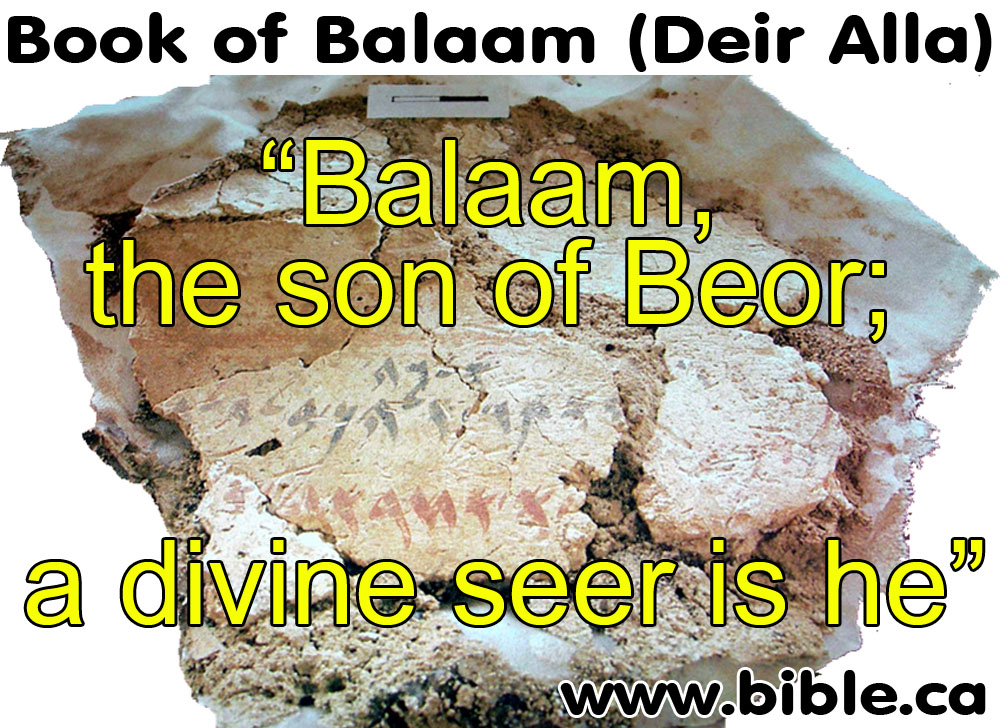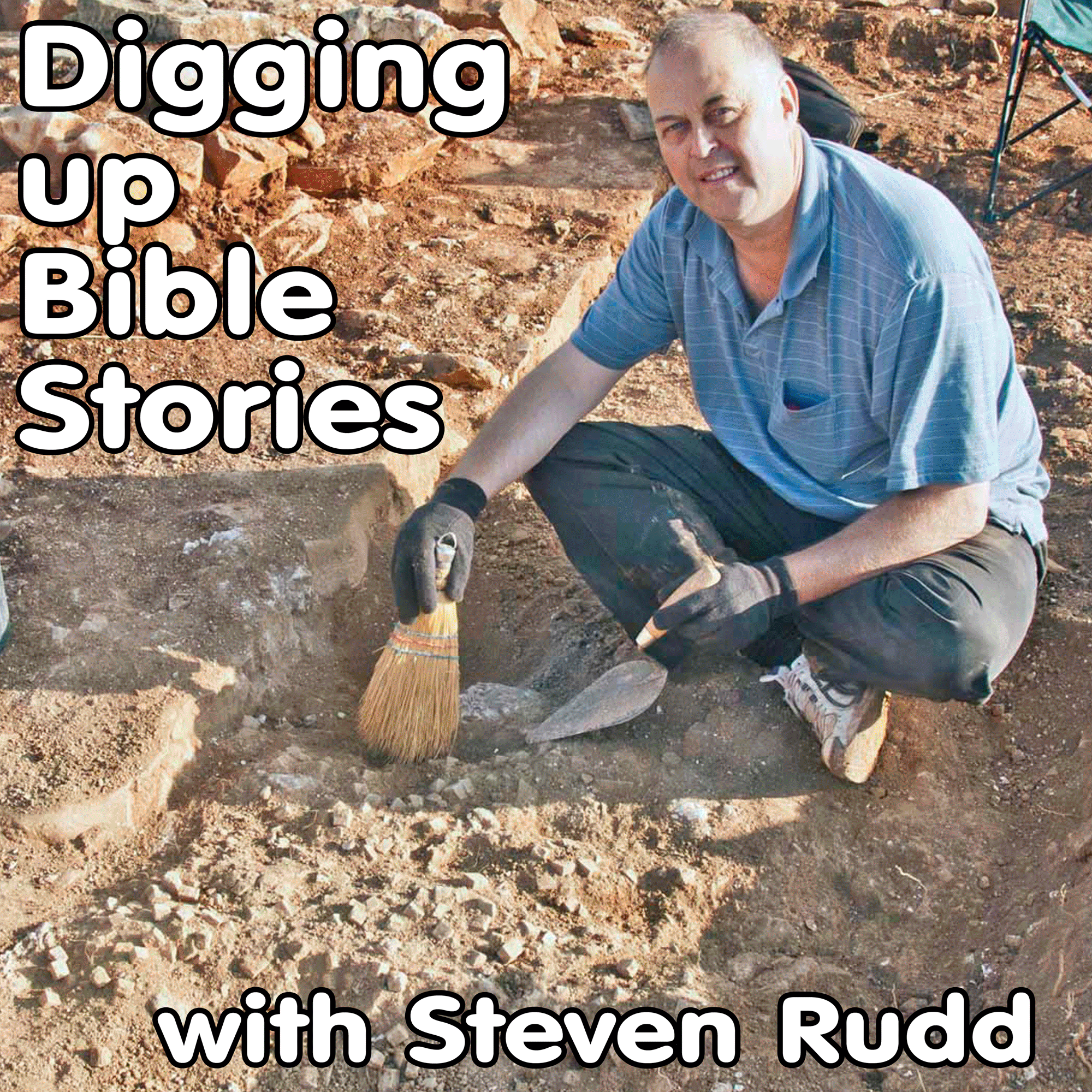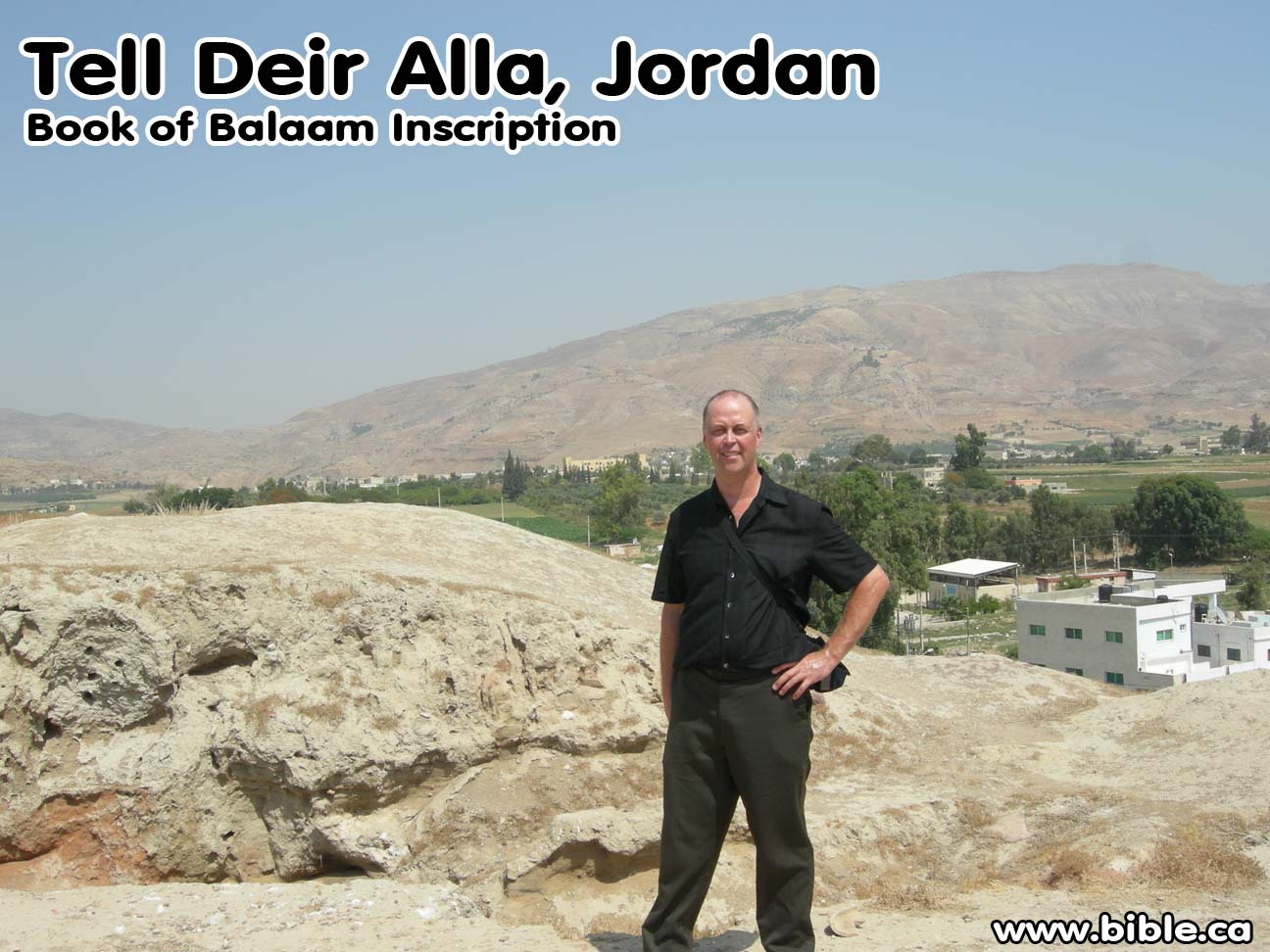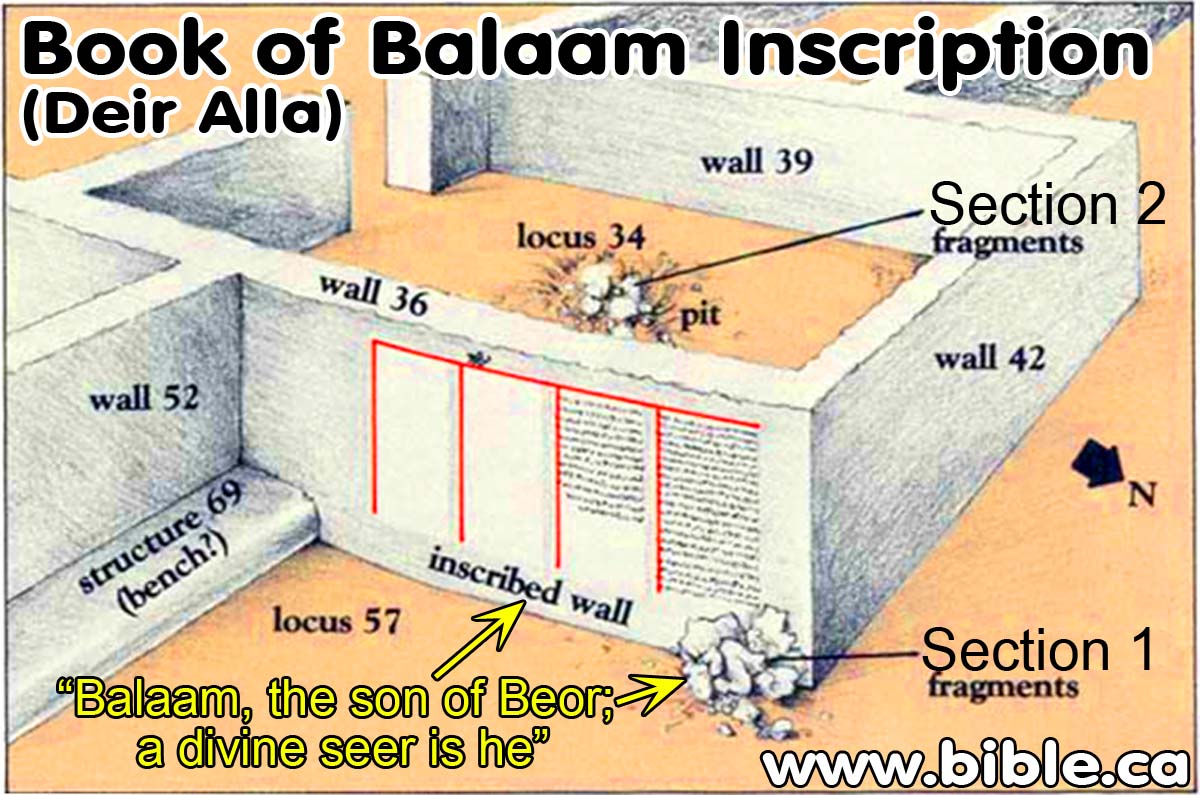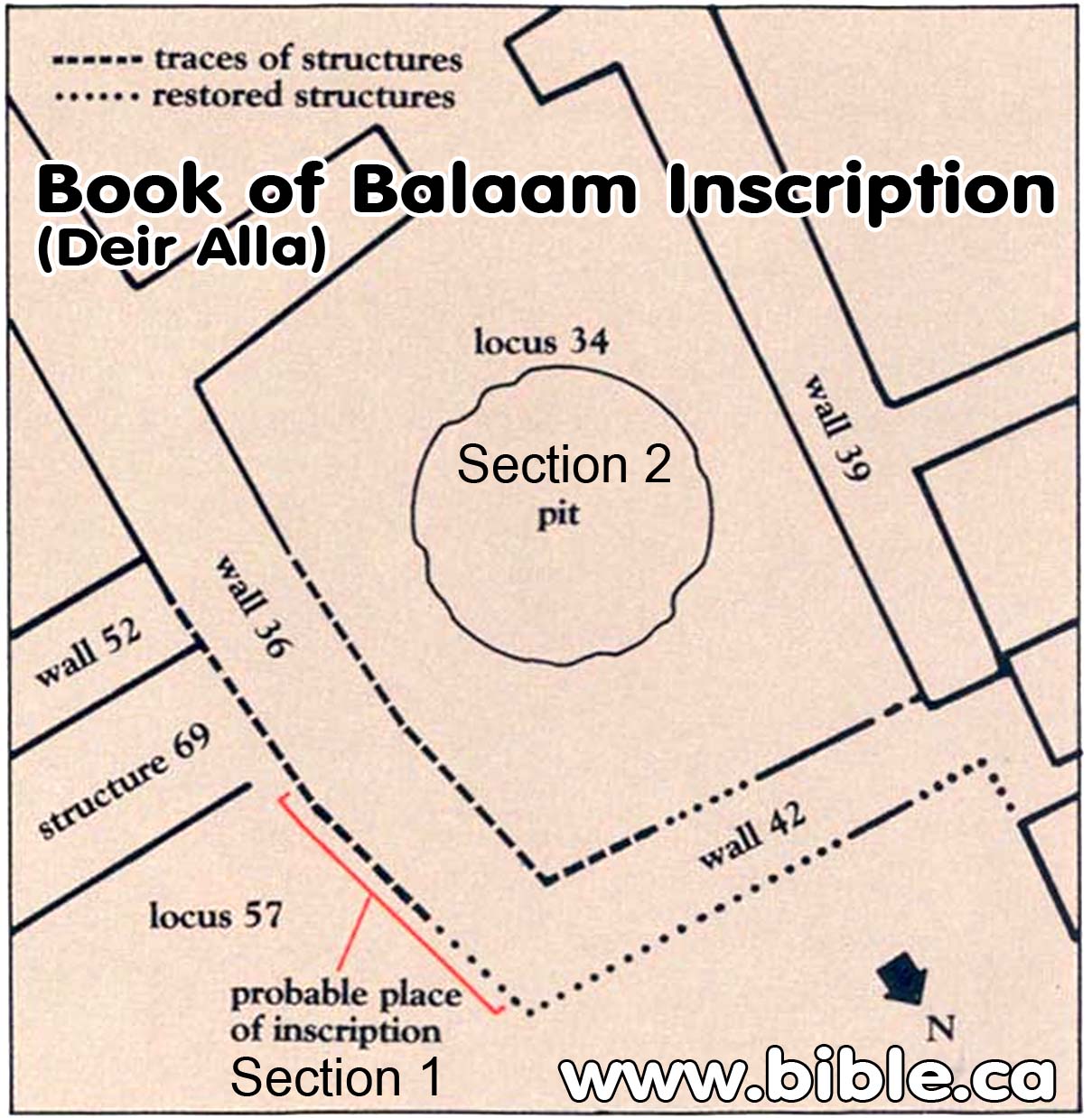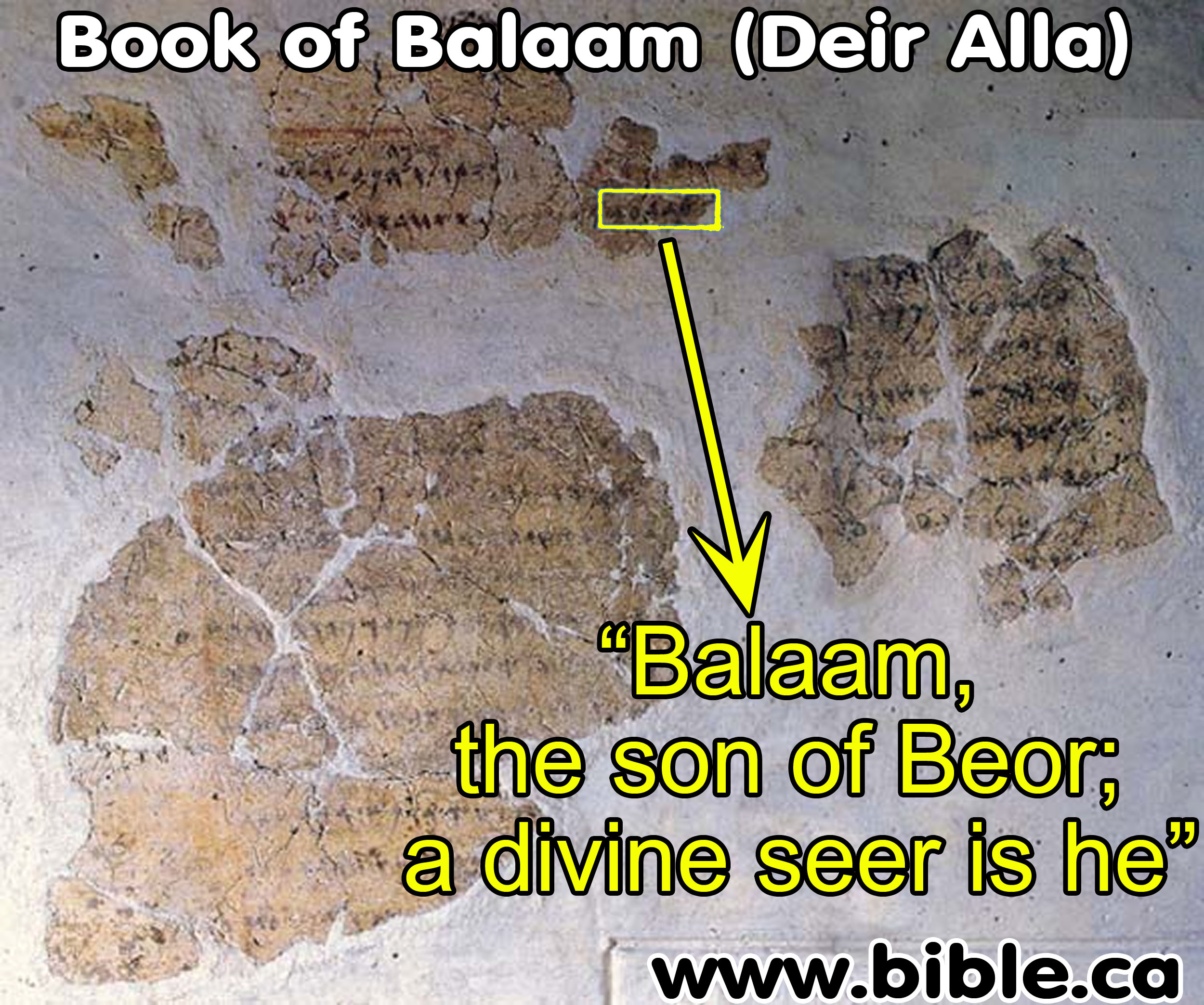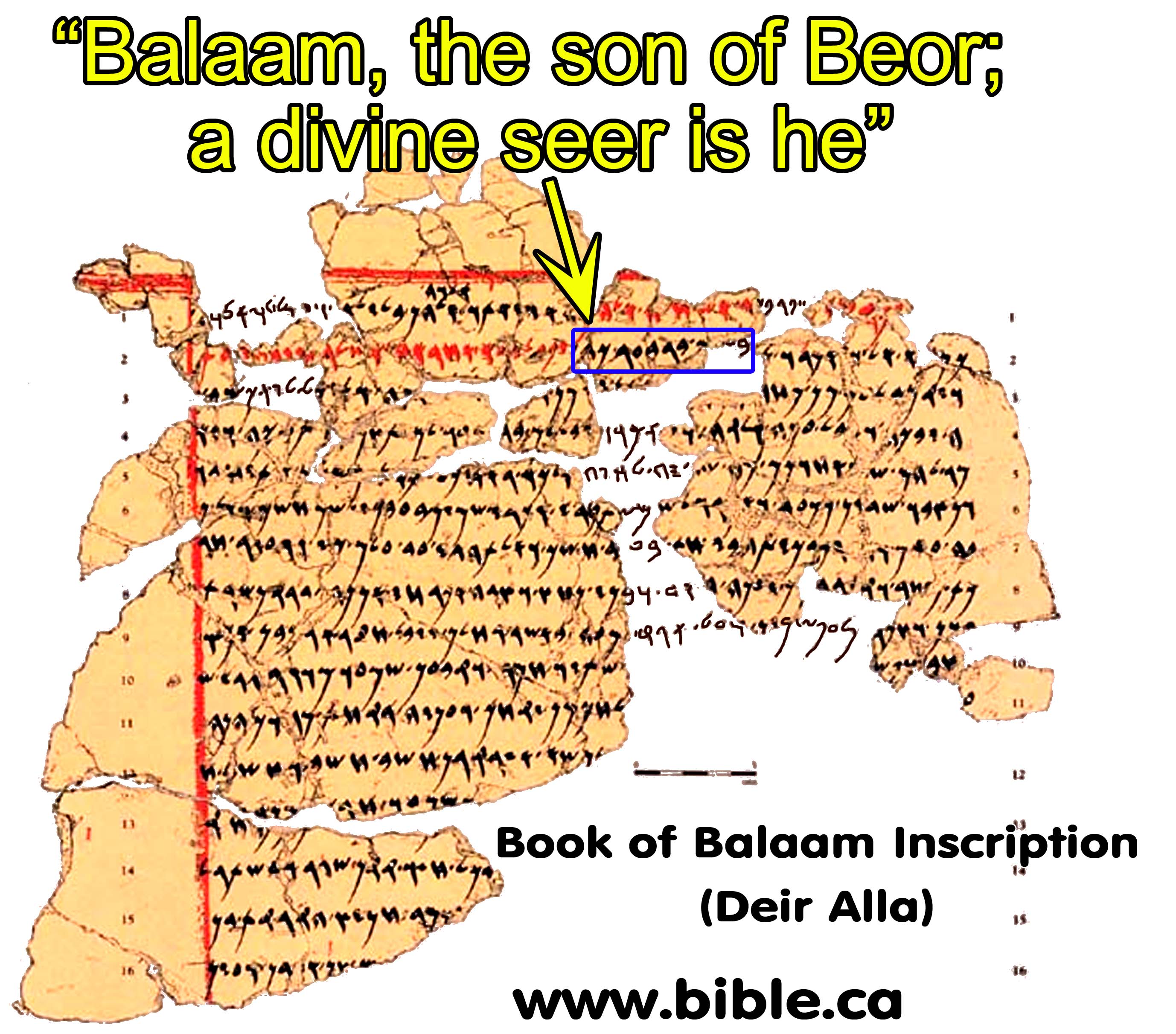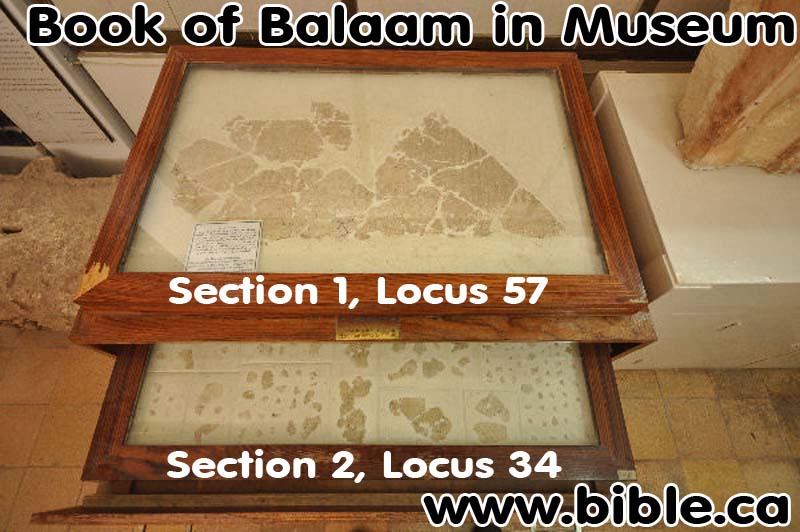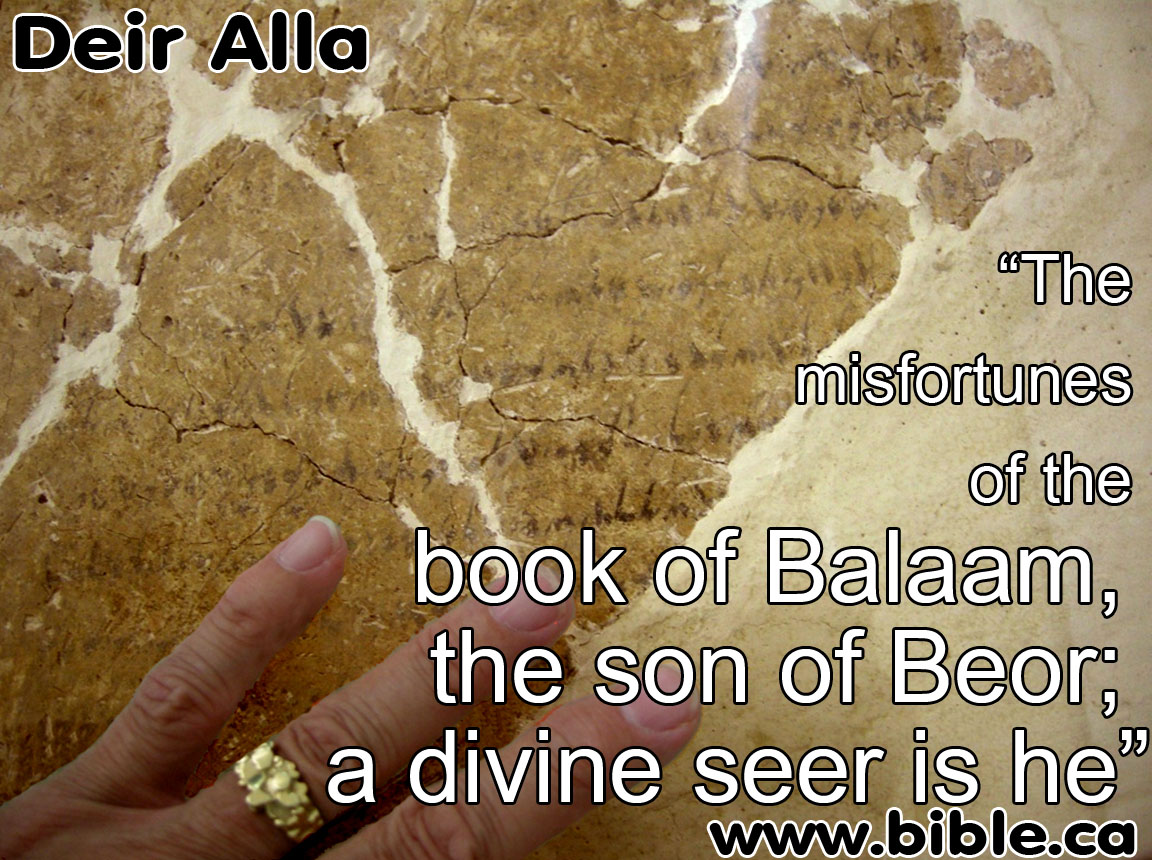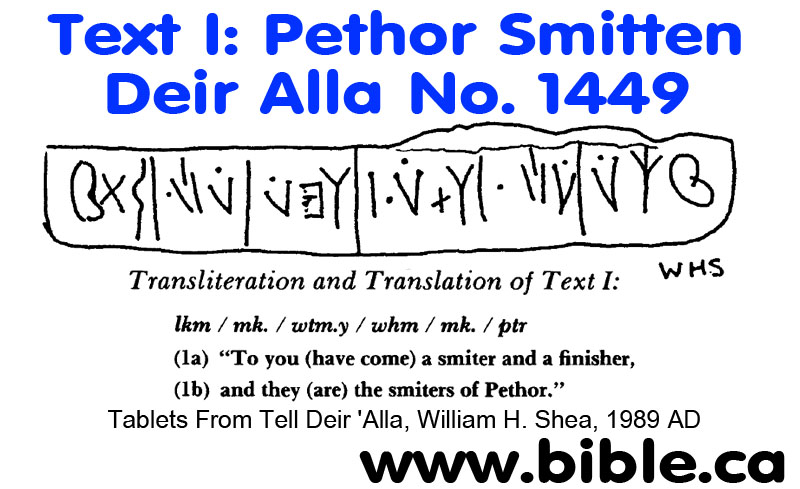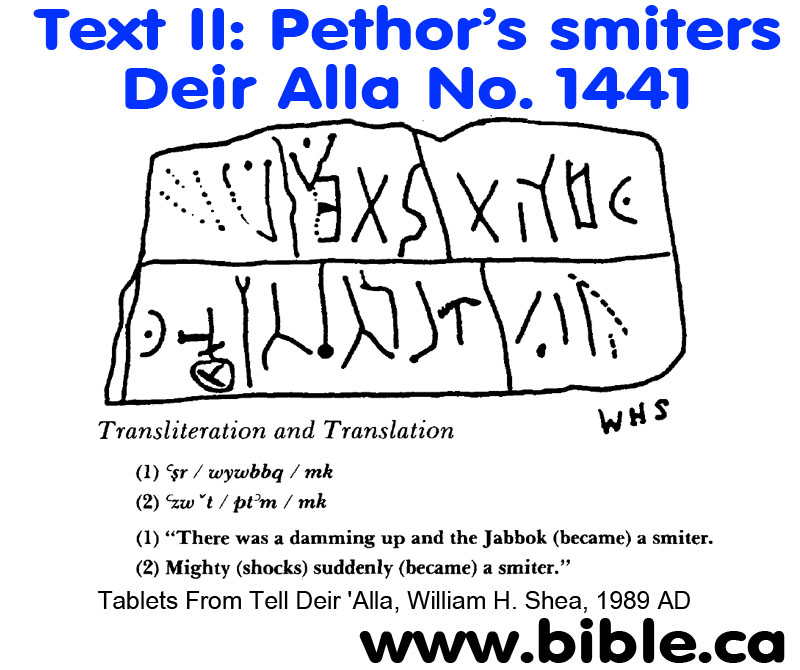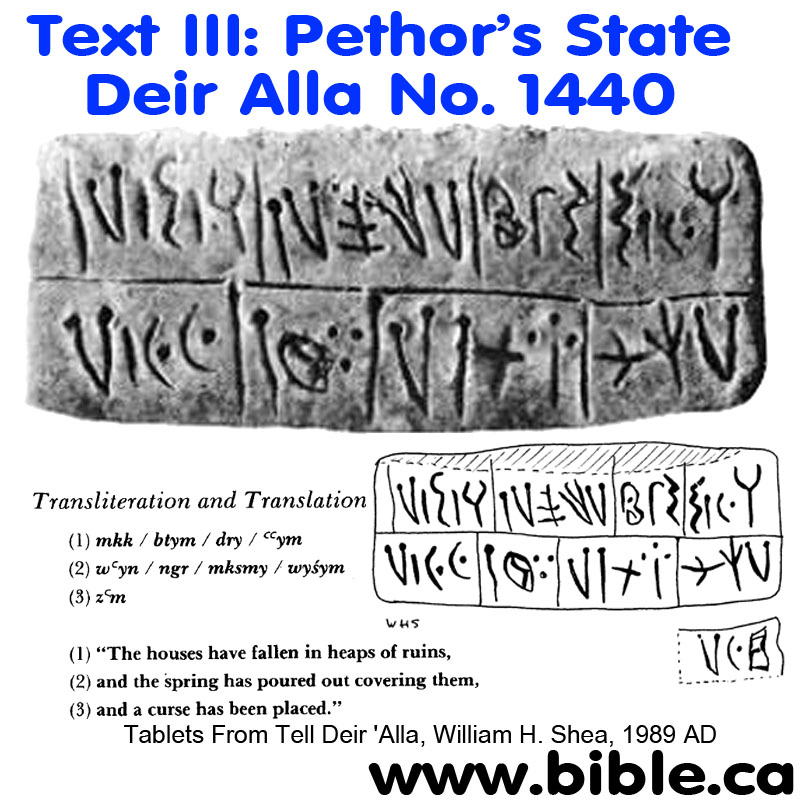Balaam Son of Beor Inscription at Tell Deir Alla, Succoth: 1406/750 BC
|
|
||
|
"The warning of the Book of Balaam, son of Beor, who was a seer of the gods." 1. Echoing the Bible exactly, the phrase “Balaam son of Beor" is found three times in the first four lines of the Balaam wall inscription that dates to 750 BC. 2. The God referred to in the inscription is "el" and "Shaddai" which is again exactly how God was referred to during the period before Moses. 3. Deir Alla, is identified with Succoth may also be identified with Pethor from a tablet discovered here. |
||
|
Archaeologists are digging up bible stories!!! |
||
|
Archaeology is an important science that confirms the historical accuracy of the Bible. Since the Bible refers to hundreds of cities, kings, and places, we would expect to find evidence from on-site excavations. And this is exactly what we have found. The Bible is the most historically accurate book of history on earth. Read the Bible daily! |
|
|
Introduction:
1. "Now that the ass episode is recognized as an interpolation, one can inquire as to its purpose. Why was it inserted here? The goal of the episode is doubtless the humiliation of Balaam, evidenced by the strain of irony that runs through the entire pericope (and recognized by the midrash). Balaam, who desires to subdue Israel with words, cannot even subdue his ass with a stick (Tanḥ. Balak 9).
a. Balaam, who claims prophetic sight (24:4, 17), cannot see what his ass sees three times.
b. Balaam, who claims prophetic speech since the Lord puts words into his mouth (22:38; 23:5, 12, 16), is now matched by his ass (v. 28).
c. Balaam, who boasts that “his knowledge is from the Most High” (24:16), has to admit, “I did not know” (v. 34; Tanḥ. Balak 10).
d. Balaam, who is the wisest of the wise, is bested in a verbal exchange with the most stupid of beasts (v. 30; Gen. R. 93:10; Num. R. 20:14).
e. Balaam, who wishes to slay a whole people with his words, can only kill his ass with a sword (Num. K 20:14).
f. Balaam, who would slay his ass if only he could find a sword (v. 29), does not see the sword extended by the angel (v. 23).
g. Thus “the ass in this episode plays the role of Balaam—beholding divine visions with eyes unveiled—to Balaam’s Balak.” In truth, Balaam is depicted on a level lower than his ass: more unseeing in his inability to detect the angel, more stupid in being defeated verbally by his ass, and more beastly in subduing it with his stick whereas it responds with tempered speech. (Jps Torah Commentary, J. Milgrom Numbers 22, 1990 AD)
2. GUESS 5 ANIMALS THAT TALK IN THE BIBLE:
a. "Hey baby, wanna do dinner?" Snake: Gen 3:1f
b. "Cry to God who supplies all needs" birds: Job 35:11; 12:7–10; Ps 104:21, 147:9; Joel 1:20; Luke 12:24
c. “Amen. Hallelujah!” 4 creatures of Revelation 19:4
d. "I am sooo amazing" Nebuchadnezzar/ox: Daniel 4:30–32
e. "Are you blind?" Balaam's donkey: Numbers 22-23
I. Photo-gallery of Tell Deir Alla in Jordan: Click on photos for high resolution
1. Panorama photo of Deir Alla
2. The author on Tell Deir Alla
II. The discovery of the Book of Balaam inscriptions:
1. "In an unprecedented discovery, an ancient text found at Deir Alla, Jordan, in 1967 tells about the activities of a prophet named Balaam. Could this be the Balaam of the Old Testament? The text makes it clear that it is. Three times in the first four lines he is referred to as “Balaam son of Beor,” exactly as in the Bible. This represents the first Old Testament prophet to be dug up in Bible lands — not his tomb or his skeleton, but a text about him. The text also represents the first prophecy of any scope from the ancient West Semitic world to be found outside the Old Testament, and the first extra-Biblical example of a prophet proclaiming doom to his own people. … The remarkable text found at Deir Alla consists of 119 fragments of plaster inscribed with black and red ink. It was among the rubble of a building destroyed in an earthquake. It seems to have been one long column with at least 50 lines, displayed on a plastered wall. According to the excavators’ dating, the disaster was most likely the severe earthquake which occurred in the time of King Uzziah (Azariah) and the prophet Amos in about 760 BC (Am 1:1; Zec 14:5). The lower part of the text shows signs of wear, indicating that it had been on the wall for some time prior to the earthquake." (Balaam Son of Beor, Bible and Spade, Bryant G. Wood, p114, 1995 AD)
2. "Deir Alla in the eighth-century B.C. was a large city, perhaps even a center of religious instruction. On the walls of a room in one building that may have stood near a temple, a professional scribe copied the text of an important religious manuscript. First he drew four red frames. Then he filled the frames with text, adding a drawing here and there for adornment. See artist’s reconstruction of how this inscribed wall may have looked. Sometime in the eighth century B.C. Deir Alla was leveled by an earthquake, perhaps the very earthquake mentioned in the Book of Amos, and also spoken of by Zechariah as “the earthquake that stopped up the valley in the days of King Uzziah of Judah.” In the Deir Alla disaster, the inscribed wall fell, crumbling into a myriad of fragments that scattered over an area of more than 20 square feet. The author observes that most of one section of the wall seems to have fallen in a pit, while another section fell at the corner of the original wall (see plan)." (Fragments from the Book of Balaam Found at Deir Alla, André Lemaire, BAR-11:05, Sep/Oct 1985)
3. "Found at Tell Deir ʿAllā, near the River Zerqa (biblical Jabbok) in the eastern Jordan Valley, these texts were apparently once displayed in a room of a building that is commonly believed to have been a sanctuary. Written in black and red ink on white plaster, fragments of the texts were found on the floor of that room when the building was destroyed by a violent earthquake—one of the many that plagued the region. As a result of that disaster, part of the plaster was burnt and the entire inscription fell to the ground, shattered in pieces, much of which was irretrievably lost. The fragments that remain were found in several groupings." (Deir Alla Plaster Texts, Prophets and prophecy in the ancient Near East, Vol 12, 138, 2003 AD)
4. "Combination I clearly concerns the vision of Balaam son of Beor, “a seer of the gods,” who is also known in the biblical tradition recorded in Num 22–24. Like the prophets of ancient Israel, Balaam in this account is privy to the deliberations of the divine council. The assembled deities—known in the account alternatively as “gods” and “Shaddayin” (a term related to the biblical divine epithet “Shaddai”)—have ordained a catastrophe, and they charge a certain celestial being to execute the destruction on their behalf. Unfortunately, only the first letter of her name has been preserved (line 6), so her identity can only be a matter of conjecture. Like the deceiving spirit sent forth from the divine council witnessed by the prophet Micaiah the son on Imlah (1 Kgs 22:5–18) and like the adversary in the divine council who was permitted by God to set forth to harm Job (Job 1:6–12; 2:1–8), she plays a destructive role. The impending doom that she is to bring about is in many ways reminiscent of end-of-the-world scenarios that are often found in the Bible, notably in the preaching of the prophets. Creation will apparently be undone as the cosmic floods will be released upon the earth (“the bolts of heaven” will be broken), the dark rain clouds will cover the skies, and there will be pitch darkness and terror on earth." (Deir Alla Plaster Texts, Prophets and prophecy in the ancient Near East, Vol 12, 138, 2003 AD)
III. Digging up another Bible story: The book of Balaam
1. The Balaam inscriptions are one of the most important archeological discoveries of all time that date to 750 BC but confirm the story of Numbers 22 that dates to 1406 BC.
2. There is no question about the connection of the inscription with Balaam. Trust your Bible!
3. "In an unprecedented discovery, an ancient text found at Deir Alla, Jordan, in 1967 tells about the activities of a prophet named Balaam. Could this be the Balaam of the Old Testament? The text makes it clear that it is. Three times in the first four lines he is referred to as “Balaam son of Beor,” exactly as in the Bible." (Balaam Son of Beor, Bible and Spade, Bryant G. Wood, p114, 1995 AD)
4. Click on the photos for high resolution:
IV. The Museum exhibit in Amman, Jordan
1. In an old, musty, run-down, insecure museum in Amman, Jordan lay some of the most important archeological Bible artifacts on earth for 50 years. Fortunately, the locals, probably for tourist dollars, decided to build a new museum to house these treasures that include some of the original Dead Sea Scroll benches discovered at Qum'ran. Here is how the Book of Balaam looked for 50 years. Under the direct supervision of the lax and indifferent museum security, our team of archeologists carefully lifted the glass and photographed the Balaam inscriptions.
2. "What are being called “inscriptions” are actually texts pieced together from fragments of plaster that had fallen to the floor from the inner walls of a building. That structure was part of a manufacturing and distribution center located on the mound, where some religious activity may have taken place. The inscriptions, written in ink on plaster with a nib, were displayed on the walls. They belong to stratum IX at the site, which has been dated to the ninth and eighth centuries bce, with the inscriptions, themselves, dated on the basis of laboratory tests to ca. 800 bce (Ibrahim and van der Kooij 1991). Tel Deir ʿAlla is located about eight kilometers east of the Jordan, not far from the northern bank of the Zerqa river (the biblical Jabbok), which flows into the Jordan. The plaster inscriptions are on display in the Archaeological Museum in Amman, Jordan." (Monumental Inscriptions from the Biblical World, Context of Scripture, William W. Hallo, volume II, 2.27, 2000 AD)
V. Full free online translation of the text of the Book of Balaam inscriptions:
1. This translation from: Monumental Inscriptions from the Biblical World, Context of Scripture, William W. Hallo, volume II, 2.27, 2000 AD
2. Remember, there are two different set of inscriptions that were found in two different places on the tell.
a. Section I was the message with the words, "Balaam, son of Peor" was written on the wall of the building in three red panels of text in locus 57.
b. Section II was the smaller sections that were found in the middle of a room floor pit of locus 34.
3. Section 1, Locus 57 notes:
a. "The contents of Combination I may be summarized as follows: Balaam is visited at night by gods sent to communicate to him a message from El, the high god. It is a message of doom, and Balaam is so distressed that he weeps and fasts for two days. Convening his intimates, Balaam discloses to them what has been revealed to him in the vision. A council (mwʿd = Hebrew môʿēd) of inimical gods, opposing El, has commanded the goddess Shagar-and-Ishtar, a Venus figure of light and fertility, to sew up the heavens producing darkness, and never to speak again. Celestial darkness will cause frenzy on earth, with birds of prey shrieking. Balaam interprets the vision to refer to an impending disaster in the land. Grazing land will be lost to wild beasts, and the flocks will be scattered. At this point, it becomes less clear what is happening. As interpreted here, the text relates that Balaam undertook the rescue of the goddess from the edict of the council of inimical gods, in accordance with the will of El who had forewarned him. Shagar-and-Ishtar is brought to various magical practitioners and oracles, as Balaam issues admonitions to her adversaries and dispatches powerful agents against them. The adversaries of Shagar-and-Ishtar suffer distress for all to see. Although the text becomes progressively more fragmentary, it is apparent that what had been threatened did not happen; the goddess did not sew up the heavens, and the land was not devastated. The adversaries heard incantations pronounced against them. Domesticated animals drove off the wild beasts." (Monumental Inscriptions from the Biblical World, Context of Scripture, William W. Hallo, volume II, 2.27, 2000 AD)
b. The phrase "Balaam, son of Beor" is found three times in the first four lines.
c. Notice the words "el" and "Shaddai-gods" that refer to god in the tablets is the same as Abraham used to address God as El-Shaddai = God Almighty.
d. "What has become clear is that the inscriptions are a product of the place where they were discovered: in the Valley of Succoth of biblical times, in the land of Gilead. They date from the period prior to the invasions of Tiglat-Pileser III (734–732 bce), which resulted in mass deportations from the area. Given what is known of the immediate region in the early to mid-eighth century bce, it is likely that Israelites constituted the principal element in the Gileadite population. It has been argued that, indeed, the inscriptions speak for Gileadite Israelites who worshipped El, a regional deity." (Monumental Inscriptions from the Biblical World, Context of Scripture, William W. Hallo, volume II, 2.27, 2000 AD)
e. The overall story of a lower pagan god (goddess Shagar/ Shagar-and-Ishtar) coming before a council of higher gods (Shaddai-gods) is very typical of what we find in the flood tablets of Atra-Hasis and Gilgamesh.
4. Section 2, Locus 34 notes:
a. "Combination II begins by relating that after engaging in lovemaking, El constructed a netherworld, described as a “house” where no traveler enters, where no bridegroom goes. The text continues with descriptions of the netherworld reminiscent of Isaiah, chapter 14, the biblical oracle of Sheol. The word Sheol (šʾl) may actually occur in the text. We read that the corpse moans in the nether world. The unusual word used to designate a corpse, nqr, is known from Isa 14:19 in its Hebrew form, nēṣer. Alongside the depiction of the half-existence of kings in Sheol, of worm rot and shrouds, where human feelings and quests are lacking, we read of an unnamed, wise counselor being denied his craft; deprived of his ability to pronounce oracles and execrations. It is suggestive to associate such a fate with Balaam, the protagonist of Combination I, although Balaam’s name is not attested in Combination II as we have it. In the following, uncertain translations are italicized." (Monumental Inscriptions from the Biblical World, Context of Scripture, William W. Hallo, volume II, 2.27, 2000 AD)
b. The word for "sheol" (New Testament "hades") is used and the after life world of the dead is under discussion.
c. The words and general discussion closely parallels several old testament passages that speak of conscious life after death:
i. Job, 2000 BC: ““But the falling mountain crumbles away, And the rock moves from its place; Water wears away stones, Its torrents wash away the dust of the earth; So You destroy man’s hope. “You forever overpower him and he departs; You change his appearance and send him away. “His sons achieve honor, but he does not know it; Or they become insignificant, but he does not perceive it. “But his body pains him, And he mourns only for himself.”” (Job 14:18–22)
ii. Isaiah, 730 BC: “that you will take up this taunt against the king of Babylon, and say, “How the oppressor has ceased, And how fury has ceased! “The Lord has broken the staff of the wicked, The scepter of rulers Which used to strike the peoples in fury with unceasing strokes, Which subdued the nations in anger with unrestrained persecution. “The whole earth is at rest and is quiet; They break forth into shouts of joy. “Even the cypress trees rejoice over you, and the cedars of Lebanon, saying, ‘Since you were laid low, no tree cutter comes up against us.’ “Sheol from beneath is excited over you to meet you when you come; It arouses for you the spirits of the dead, all the leaders of the earth; It raises all the kings of the nations from their thrones. “They will all respond and say to you, ‘Even you have been made weak as we, You have become like us. ‘Your pomp and the music of your harps Have been brought down to Sheol; Maggots are spread out as your bed beneath you And worms are your covering.’ “How you have fallen from heaven, O star of the morning, son of the dawn! You have been cut down to the earth, You who have weakened the nations! “But you said in your heart, ‘I will ascend to heaven; I will raise my throne above the stars of God, And I will sit on the mount of assembly In the recesses of the north. ‘I will ascend above the heights of the clouds; I will make myself like the Most High.’ “Nevertheless you will be thrust down to Sheol, To the recesses of the pit. “Those who see you will gaze at you, They will ponder over you, saying, ‘Is this the man who made the earth tremble, Who shook kingdoms, Who made the world like a wilderness And overthrew its cities, Who did not allow his prisoners to go home?’ “All the kings of the nations lie in glory, Each in his own tomb. “But you have been cast out of your tomb Like a rejected branch, Clothed with the slain who are pierced with a sword, Who go down to the stones of the pit Like a trampled corpse. “You will not be united with them in burial, Because you have ruined your country, You have slain your people. May the offspring of evildoers not be mentioned forever.” (Isaiah 14:4–20)
iii. Isaiah, 730 BC ““Then they will go forth and look On the corpses of the men Who have transgressed against Me. For their worm will not die And their fire will not be quenched; And they will be an abhorrence to all mankind.”” (Isaiah 66:24)
iv. Jesus, 30 AD: ““Whoever causes one of these little ones who believe to stumble, it would be better for him if, with a heavy millstone hung around his neck, he had been cast into the sea. “If your hand causes you to stumble, cut it off; it is better for you to enter life crippled, than, having your two hands, to go into hell, into the unquenchable fire, [where their worm does not die, and the fire is not quenched.] “If your foot causes you to stumble, cut it off; it is better for you to enter life lame, than, having your two feet, to be cast into hell, [where their worm does not die, and the fire is not quenched.] “If your eye causes you to stumble, throw it out; it is better for you to enter the kingdom of God with one eye, than, having two eyes, to be cast into hell, where their worm does not die, and the fire is not quenched. “For everyone will be salted with fire.” (Mark 9:42–49)
v. Jesus, 30 AD: ““Now there was a rich man, and he habitually dressed in purple and fine linen, joyously living in splendor every day. “And a poor man named Lazarus was laid at his gate, covered with sores, and longing to be fed with the crumbs which were falling from the rich man’s table; besides, even the dogs were coming and licking his sores. “Now the poor man died and was carried away by the angels to Abraham’s bosom; and the rich man also died and was buried. “In Hades he lifted up his eyes, being in torment, and saw Abraham far away and Lazarus in his bosom. “And he cried out and said, ‘Father Abraham, have mercy on me, and send Lazarus so that he may dip the tip of his finger in water and cool off my tongue, for I am in agony in this flame.’ “But Abraham said, ‘Child, remember that during your life you received your good things, and likewise Lazarus bad things; but now he is being comforted here, and you are in agony. ‘And besides all this, between us and you there is a great chasm fixed, so that those who wish to come over from here to you will not be able, and that none may cross over from there to us.’” (Luke 16:19–26)
|
|
COMBINATION I: (SECTION I: Locus 57) Title (line 1) The misfortunes of the Book of Balaam, son of Beor.2 A divine seer was he.3 The Theophany (lines 1–4) The gods came to him at night, And he beheld a vision in accordance with El’s utterance.4 They said to Balaam, son of Beor: “So will it be done, with naught surviving, No one has seen [the likes of] what you have heard!” Balaam Reports his Vision to his Intimates (lines 4–7) Balaam arose on the morrow; He summoned the heads of the assembly unto him, And for two days he fasted, and wept bitterly. Then his intimates entered into his presence, And they said to Balaam, son of Beor: “Why do you fast, And why do you weep?” Then he said to them: “Be seated, and I will relate to you what the Shaddai-godse have planned, And go, see the acts of the gods!” f Balaam Describes the Celestial Vision and Its Aftermath in the Land (lines 7–13) “The gods have banded together; The Shaddai-gods have established a council. g And they have said to [the goddess] Shagar: ‘Sew up, close up the heavens with dense cloud, That darkness exist there, not brilliance; h Obscurity and not clarity; So that you instill dread in dense darkness. And — never utter a sound again!’ ” “It shall be that the swift and crane will shriek insult to the eagle, And a nest of vultures shall cry out in response. The stork, the young of the falcon and the owl, The chicks of the heron, sparrow and cluster of eagles; Pigeons and birds, [and fowl in the s]ky.”i “And a rod [shall flay the cat]tle; Where there are ewes, a staff shall be brought. Hares — eat together! Free[ly feed,] oh beasts [of the field]! And [freely] drink, asses and hyenas!” Balaam Acts to Save the Goddess and the Land (lines 13–14) Heed the admonition, adversaries of Sha[gar-and-Ishtar]!17 [ skilled diviner. To skilled diviners shall one take you, and to an oracle; [To] a perfumer of myrrh and a priestess. [Who] covers his body [with oil], And rubs himself with olive oil. To one bearing an offering in a horn; One augurer after another, and yet another. As one augurer broke away from his colleagues. The strikers departed [ ] The Admonitions are Heeded; The Malevolent Gods are Punished, the Goddess Rescued, and the Land Saved (lines 14–18) They heard incantations from afar. [ ] Then disease was unleashed, And all beheld acts of distress. Shagar-and-Ishtar did not [ ] The piglet [drove out] the leopard; And [the ] drove out the young of [the ]. [ ] double offerings. And he beheld [ ] Monumental Inscriptions from the Biblical World, Context of Scripture, William W. Hallo, volume II, 2.27, 2000 AD |
|
|
|
|
|
COMBINATION II: (SECTION II, locus 34) EXCERPT A: El builds a necropolis (lines 6–7) El satisfied himself with [lovemaking]; And then El fashioned an eternal house; m [A house ], A house where no traveler enters,2 Nor does a bridegroom enter there. EXCERPT B: A Half-existence in Sheol (line 8) Worm rot from a grave. From the reckless affairs of men, And from the lustful desires of people EXCERPT C: The Rejection of a Seer (line 9) If it is for counsel, one will not counsel with you! Or for advising him, one will not take advice! EXCERPTS D-E: More on Conditions in Sheol (lines 10–11) From the bed they cover themselves with a wrap. If you hate him, he will be mortally afflicted. If you [ ] - - - - - [Worm rot] is under your head. You shall lie on your eternal bedding, To pass away to [ ] EXCERPTS F-G: Kings and Other Corpses in Sheol (lines 12–15) [ ] in their heart. The corpse moans in his heart q He moans [ ] - - - - - [ ] a daughter. There, kings behold [ ]. There is no mercy when Death seizes a suckling. And a suckling [ ]; And a suckling [ ]; A suckling [ ]; There [ ] shall be. The heart of the corpse is desolate As he approaches [Sheol]. [ ]. To the edge of She[ol], s And the shadow of the hedge [ ]. EXCERPTS H-I: An Oracle: The Quests of Kings and Seers Come to Naught (lines 5–17) “The quest of a king is moth rot, And the quest of [ ]; [ ] seers. Your quest is distant from you. To know how to deliver an oracle to his people. You have been condemned for your speech, And [banned] from pronouncing words of execration.” Monumental Inscriptions from the Biblical World, Context of Scripture, William W. Hallo, volume II, 2.27, 2000 AD |
|
|
|
VI. Eleven Tablets from Deir Alla was Balaam's home called Pethor date earlier than 1200 BC:
Completely distinct from the Balaam inscriptions that were found, are these 11 tablets. Most striking is the possible reference to Pethor and a natural disaster that occurred before 1200 BC. These 11 tablets, may in fact have been created by Balaam himself before he died, as a prophecy of Joshua crossing the Jordan River, which backed up to Adam so Israel could cross on dry land. Although highly speculative, perhaps Balaam wrote these tablets as part of a prophecy which came true after he died as a witness to all.
|
|
||
|
Full text of the 11 tablets from Deir Alla |
||
|
"The translation developed here for this six-word line thus not only identifies as Pethor the site at which the tablet was found, but also indicates that Pethor had been attacked by two successive waves of attackers. Although this text does not identify those attackers, it appears that the related tablet written in the same scribal hand (Text II) does indeed identity those attackers." (The Inscribed Tablets From Tell Deir 'Alla, William H. Shea, The Biblical Research Institute, Andrews University Seminary Studies, Vol. 27, No. 1,2147, Part I, 1989 AD) |
"From these letter identifications the word written after the conjunction in this word-box can be identified as ywbbq. This corresponds rather directly with the way in which the name of the Jabbok River was written in the biblical text, with only two minor variations. " … "The final word of this line, mk, refers to a "smiter," and should be identified linguistically as it was in Part I. The proper name which precedes it identifies that "smiter," i.e., the Jabbok River after it was dammed up and overflowed this area. Text I mentions, but does not identify, "smiters" of the region. Text I1 reveals that the river which overflowed after it was dammed up was one of these smiters. " (The Inscribed Tablets From Tell Deir 'Alla, William H. Shea, The Biblical Research Institute, Andrews University Seminary Studies, Vol. 27, No. 1,2147, Part I, 1989 AD) |
"The falling down of houses referred to in the first line of this text is interpreted here as being caused by an earthquake, presumably the same earthquake mentioned at the end of text 11. Knocking down the houses was the first destructive action of this quake, hence it was mentioned first on the tablet. The quake also fractured the water table of the spring at the site causing it to overflow upon the ruins of the fallen houses. This was the "covering" of "them," i.e., the ruined houses mentioned in the second line of this text. The final line of this text refers to the curse, either that from which these effects resulted, or that which was pronounced upon the site after its destruction. " (The Inscribed Tablets From Tell Deir 'Alla, William H. Shea, The Biblical Research Institute, Andrews University Seminary Studies, Vol. 27, No. 1,2147, Part I, 1989 AD) |
|
Final Translation: "To you have come a smiter and a finisher, and they are the smiters of Pethor." |
Final Translation: "There was a damming up and the Jabbok became a smiter. Strong and sudden (shocks) became a smiter." |
Final Translation: "The houses fell in heaps of ruins, and the spring has poured out covering them, and a curse has been placed." |
1. Discovery of 11 tablets
a. "In view of Balaam being revered at Deir Alla, one would expect that Deir Alla was his home. This is exactly what William Shea has proposed, based on his reading of the name Pethor in an inscribed clay tablet found at Deir Alla (1989:108–11). In this case, the river of Numbers 22:5 would be the Jabbok river and the naharaim (two rivers) of Deuteronomy 23:4 would be the Jabbok and Jordan rivers. With regard to the references to Aram, Shea suggests that the original place name was Adam, with the “d” being miscopied as “r,” since the two letters are nearly identical in ancient Hebrew. Adam was a town about 8 mi south-west of Deir Alla, on the east bank of the Jordan river, where the Jabbok meets the Jordan." (Balaam Son of Beor, Bible and Spade, Bryant G. Wood, p115, 1995 AD)
b. "Pethor is identified in Num 225 as the home of Balaam the prophet. These three tablets texts (I, II, III) thus provides us with an identification for that site, which previously was in dispute. Both the location of Pethor and the ancient name of Tell Deir 'Alla have been uncertain, but thanks to this text, those two puzzle pieces can now be put together by identifying Tell Deir 'Alla as Pethor." (The Inscribed Tablets From Tell Deir 'Alla, William H. Shea, The Biblical Research Institute, Andrews University Seminary Studies, Vol. 27, No. 1,2147, Part I, 1989 AD)
2. The earthquake and flood described in the 11 tablets:
a. "This type of event is known to have happened in this region when the Jordan River was temporarily dammed up by earthquakes that knocked in its west bank near Damiyeh, biblical Adam, in 1267, 1546, 1906, and 1927 A.D. If a damming up of the Jordan was located below its confluence with the Jabbok, then such an obstruction would naturally have had a similar effect upon the Jabbok River too. " (The Inscribed Tablets From Tell Deir 'Alla, William H. Shea, The Biblical Research Institute, Andrews University Seminary Studies, Vol. 27, No. 1,2147, Part I, 1989 AD)
b. "My new reading of the next word now indicates that these "mighty" ones, whatever they were, came upon Pethor "suddenly." Text III, discussed below, indicates that when these mighty ones came upon Pethor so suddenly, they caused the collapse of houses there. Since human attackers could be fended off for a time at least, they do not fit this description very well. The suddenness of the disaster and its effects suggest rather that the mighty ones that affected the town in this way were shock waves of an earthquake. Given the location of this site in the earthquake-prone area of the Jordan Valley and given also the archaeological evidence for earthquakes found in the excavations, such an occurrence here seems quite reasonable. " (The Inscribed Tablets From Tell Deir 'Alla, William H. Shea, The Biblical Research Institute, Andrews University Seminary Studies, Vol. 27, No. 1,2147, Part I, 1989 AD)
c. "The falling down of houses referred to in the first line of this text is interpreted here as being caused by an earthquake, presumably the same earthquake mentioned at the end of text 11. Knocking down the houses was the first destructive action of this quake, hence it was mentioned first on the tablet. The quake also fractured the water table of the spring at the site causing it to overflow upon the ruins of the fallen houses. This was the "covering" of "them," i.e., the ruined houses mentioned in the second line of this text. The final line of this text refers to the curse, either that from which these effects resulted, or that which was pronounced upon the site after its destruction. " (The Inscribed Tablets From Tell Deir 'Alla, William H. Shea, The Biblical Research Institute, Andrews University Seminary Studies, Vol. 27, No. 1,2147, Part I, 1989 AD)
3. The language off the 11 Tablets
a. "The conclusion from these linguistic data is that either these tablets were written by Hebrews, or they were written in a Transjordanian dialect of Canaanite that was very close to Biblical Hebrew. " (The Inscribed Tablets From Tell Deir 'Alla, William H. Shea, The Biblical Research Institute, Andrews University Seminary Studies, Vol. 27, No. 1,2147, Part I, 1989 AD)
4. The importance of Deir Alla in relation to Balaam and Pethor:
a. "A. Lemaire has asked the question, "Why were these literary, probably religious, texts copied on the plaster wall of a room at Deir cAlla?"18 His answer is that there probably was a sanctuary nearby. This appears to be correct, but is only part of the answer. Now, thanks to the Deir 'Alla Tablets, we can recognize that this locale was where Balaam's home sanctuary of Pethor was located. Of all the places in the entire Near East where his memory might have been preserved, this location is obviously the most likely because of its being the very spot where he lived and exercised his prophetic ministry. How appropriate, then, that a narrative text from him or about him should have been preserved at this site. " (The Inscribed Tablets From Tell Deir 'Alla, William H. Shea, The Biblical Research Institute, Andrews University Seminary Studies, Vol. 27, No. 1,2147, Part I, 1989 AD)
b. "We cannot attribute the writing of these tablets to Balaam himself, however, for he was killed before the Israelites crossed the Jordan (Num 3123); but the nature of the Deir 'Alla site as a religious center would imply the existence there of other literate persons or prophets. Most likely there was something resembling a non-Israelite school of the prophets, the staff of which included Balaam for a time; and someone among the other literate persons could have been responsible for the writing of these tablets. " (The Inscribed Tablets From Tell Deir 'Alla, William H. Shea, The Biblical Research Institute, Andrews University Seminary Studies, Vol. 27, No. 1,2147, Part I, 1989 AD)
VII. Balaam: Saint or sinner?
1. As any Bible student has noticed, there is a dichotomy in the actual narration of the story of Balaam in Numbers 22-24 and the New Testament. In the Old Testament, Balaam appears to be a faithful and obedient servant of YHWH. However in the New Testament, Balaam is portrayed as a money grubbing, self-seeking son of Satan destined for eternal damnation. Sure in Numbers he is opposed by the Angel of God, but then all seems ok when he is given permission to continue. The lesson for us in the Balaam story is that when we know for certain how God feels about something being sinful and forbidden, we condemn ourselves by asking a second time if we can do it. It is kind of like praying to God if he is Ok with you getting drunk, bedding the blonde or robbing a bank. Herein lay Balaam's sin. He asked God if he should curse Israel and was told absolutely not because Israel was blessed. At this point all is fine for Balaam since he asked a question he was not sure about and got an answer. But to keep enquiring of God if he should curse Israel shows him self-seeking for personal profit.
2. "The lampooning of Balaam, then, serves the purpose of downgrading his reputation. It aims to demonstrate that this heathen seer, who was intent on cursing Israel without God’s consent, is in reality a fool, a caricature of a seer, one outwitted even by his dumb beast. This image of Balaam—as wicked—is the one reflected in the later biblical and postbiblical literature." (Jps Torah Commentary, J. Milgrom Numbers 22, 1990 AD)
3. Philo on Balaam: "LII. (285) But Balak, being very indignant at finding that all the assistance which he expected to derive from divination was turning out contrary to his hopes, said: “O man, neither curse them at all, nor bless them at all; for silence, which is free from danger, is better than unpleasant speeches.” And when he had said this, as if he had forgotten what he had said, owing to the inconstancy of his mind, he led the prophet to another place, from which he could show him a part of the Hebrew army; and again he invited him to curse them. (286) But the prophet, as being even more wicked than the king, although he had always replied to the accusations which were brought against him with one true excuse, namely, that he was saying nothing out of his own head, but was only interpreting the words of another, being himself carried away and inspired, when he ought no longer to have accompanied him but to have gone away home, ran forward even more eagerly than his conductor, although in his secret thoughts he was oppressed by a heavy feeling of evil, yet still desired in his mind to curse this people, though he was forbidden to do so with his mouth. (Philo Moses I 284–286) Philo, usually known as Philo the Jew (Philo Judaeus) or Philo of Alexandria (a city in Egypt with a large Jewish Diaspora population in Greco-Roman times), lived from about20 B.C. to about A.D. 50. He is one of the most important Jewish authors of the Second Temple period of Judaism and was a contemporary of both Jesus and Paul. Yet, Philo is not nearly as well known or as frequently read as the first century A.D. Jewish historian Josephus. (The works of Philo complete and unabridged, David M. Scholer, Foreword, 1995 AD)
4. Josephus on Balaam: "To which Balaam replied, “O Balak, if thou rightly considerest this whole matter, canst thou suppose that it is in our power to be silent, or to say anything, when the Spirit of God seizes upon us?—for he puts such words as he pleases in our mouths, and such discourses as we are not ourselves conscious of. (120) I well remember by what entreaties both you and the Midianites so joyfully brought me hither and on that account I took this journey. It was my prayer, that I might not put any affront upon you, as to what you desired of me; (Josephus Antiquities 4.120)
5. "Thus the transformation is complete. Later tradition acknowledges almost nothing of Balaam the obedient servant of the Lord, who could not be bribed by all the wealth of Moab. He is, instead, the archetypal enemy of Israel, a Pharaoh or Haman, whose power would threaten to annihilate Israel were it not for the intervention of Israel’s God. Yet both traditions, the saint and the sinner, have their roots in Scripture, indeed, in these very chapters of the “Book of Balaam.”" (Jps Torah Commentary, J. Milgrom Numbers 22, 1990 AD)
6. The Old Testament has Balaam killed by the army of Joshua and the New Testament clearly condemns Balaam.
VIII. What the bible says about wicked Balaam:
- “They killed the kings of Midian along with the rest of their slain: Evi and Rekem and Zur and Hur and Reba, the five kings of Midian; they also killed Balaam the son of Beor with the sword.” (Numbers 31:8)
- ““Behold, these caused the sons of Israel, through the counsel of Balaam, to trespass against the Lord in the matter of Peor, so the plague was among the congregation of the Lord.” (Numbers 31:16)
3. “‘But I have a few things against you, because you have there some who hold the teaching of Balaam, who kept teaching Balak to put a stumbling block before the sons of Israel, to eat things sacrificed to idols and to commit acts of immorality.” (Revelation 2:14)
4. “But false prophets also arose among the people, just as there will also be false teachers among you, who will secretly introduce destructive heresies, even denying the Master who bought them, bringing swift destruction upon themselves. Many will follow their sensuality, and because of them the way of the truth will be maligned; and in their greed they will exploit you with false words; their judgment from long ago is not idle, and their destruction is not asleep. For if God did not spare angels when they sinned, but cast them into hell and committed them to pits of darkness, reserved for judgment; and did not spare the ancient world, but preserved Noah, a preacher of righteousness, with seven others, when He brought a flood upon the world of the ungodly; and if He condemned the cities of Sodom and Gomorrah to destruction by reducing them to ashes, having made them an example to those who would live ungodly lives thereafter; and if He rescued righteous Lot, oppressed by the sensual conduct of unprincipled men (for by what he saw and heard that righteous man, while living among them, felt his righteous soul tormented day after day by their lawless deeds), then the Lord knows how to rescue the godly from temptation, and to keep the unrighteous under punishment for the day of judgment, and especially those who indulge the flesh in its corrupt desires and despise authority. Daring, self-willed, they do not tremble when they revile angelic majesties, whereas angels who are greater in might and power do not bring a reviling judgment against them before the Lord. But these, like unreasoning animals, born as creatures of instinct to be captured and killed, reviling where they have no knowledge, will in the destruction of those creatures also be destroyed, suffering wrong as the wages of doing wrong. They count it a pleasure to revel in the daytime. They are stains and blemishes, reveling in their deceptions, as they carouse with you, having eyes full of adultery that never cease from sin, enticing unstable souls, having a heart trained in greed, accursed children; forsaking the right way, they have gone astray, having followed the way of Balaam, the son of Beor, who loved the wages of unrighteousness; but he received a rebuke for his own transgression, for a mute donkey, speaking with a voice of a man, restrained the madness of the prophet.” (2 Peter 2:1–16)
5. “Now I desire to remind you, though you know all things once for all, that the Lord, after saving a people out of the land of Egypt, subsequently destroyed those who did not believe. And angels who did not keep their own domain, but abandoned their proper abode, He has kept in eternal bonds under darkness for the judgment of the great day, just as Sodom and Gomorrah and the cities around them, since they in the same way as these indulged in gross immorality and went after strange flesh, are exhibited as an example in undergoing the punishment of eternal fire. Yet in the same way these men, also by dreaming, defile the flesh, and reject authority, and revile angelic majesties. But Michael the archangel, when he disputed with the devil and argued about the body of Moses, did not dare pronounce against him a railing judgment, but said, “The Lord rebuke you!” But these men revile the things which they do not understand; and the things which they know by instinct, like unreasoning animals, by these things they are destroyed. Woe to them! For they have gone the way of Cain, and for pay they have rushed headlong into the error of Balaam, and perished in the rebellion of Korah. These are the men who are hidden reefs in your love feasts when they feast with you without fear, caring for themselves; clouds without water, carried along by winds; autumn trees without fruit, doubly dead, uprooted; wild waves of the sea, casting up their own shame like foam; wandering stars, for whom the black darkness has been reserved forever.” (Jude 5–13)
Conclusion:
1. The discovering of the Balaam inscriptions in 1967 AD was a bad day for Bible scoffers as, once again, they dug up yet another Bible story!
2. The fantastic discovery of the two sections of the "Book of Balaam" inscriptions that date to 750 BC and the 11 tablets that date 1450-1200 BC prove Balaam was indeed the real person of Numbers 22-24.
3. The 11 tablets have been translated to show that Tell el-Deir Alla is in fact Balaam's home town of "Pethor". This would explain why 750 years after (750 BC) the death of Balaam in 1406 BC, he still played a central public role in the town.
4. The storyline of the Book of Balaam closely parallels flood stories of Atra-Hasis and Gilgamesh. (click to read) This should not surprise us since Balaam would sell his "seer services" to the highest bidder.
5. Balaam has become one of the most recognizable examples in the Bible of how not to be pleasing to God and guarantee your place beside the wicked in Sheol and in the eternal fires of Hell after judgement.
By Steve Rudd: Contact the author for comments, input or corrections.
